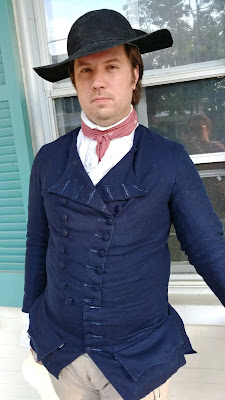Ok, so there were more like it, but I do not know of any rifles out there right now in the living history community that are like my rifle. My rifle is a to specification copy of a Maryland Council of Safety musket based off of documentation and surviving examples. What is a Council of Safety Musket you ask? I'll tell you.
A Council of Safety, more commonly a Committee of Safety, or just COS Musket were domestically produced muskets that were made in the early days of the American Revolution by each province to outfit their Provincial Line troops and militias. In 1775, seeing as the united colonies were at war with Britain in practice and Britain was most likely not going to sell munitions to the colonies that they are currently at war with, each colony's Committee of Safety (or Council of Safety in Maryland because we have to be different) past resolutions for local gunsmiths to produce muskets to outfit their troops. These domestically produced muskets, commissioned and purchased by the COSs for the provincial troops, were many of the provincial assemblies plans to arm their soldiers until the Continental Line began receiving arms from France.
Each colony's COS had different specifications for their COS musket, if they had specifications at all. Most of the muskets were based off the Brown Bess musket that was in use by the British forces. Most colonies based the design on the Short Land pattern or Second Pattern Brown Bess, but some colonies like Connecticut based the design on the older Long Land pattern Brown Bess with a distinctively longer barrel.
The Maryland Muskets were based on the Short Land Brown Bess, and had the exact same specifications as the British Musket. The exact specifications from the "Journal and Correspondence of the Maryland Council of Safety" from August 2, 1775 is below:
"...The dimensions of which may be 42 inches in length, 24 of an Inch clear in the bore 1 1/2 inch diameter at the breech, and 7/8 of an Inch at the Muzzle) with Steel rammers and Bayonets 20 Inches in length including the Stock... If this mode meets with your Approbation, we recommend, that each Gun be proved before it shall be received, and when proved, that the word Maryland be stamped on the Barrel."
My musket meets those exact specifications down to the Maryland stamping on the barrel. My musket is a Pedersoli reproduction Brown Bess that was modified by Lodgewood Mfg., a gunsmith in Wisconsin that specializes in restoring antique firearms and modifying modern reproductions to be historically accurate to the originals.
Lodgewood based the modifications of my musket on a surviving Maryland COS Musket that is in the collection of George C. Neumann and featured in his book on American arms during the Revolutions. Their write up of a more generic COS musket based on the Neumann example can be found here.
The stock of the musket has been reshaped to remove the distinctive Brown Bess features and make it more in line with the American muskets. The color was also darkened and the steel browned.
A screw was added to the thumb plate, which seems like a very small and weird feature, but it is something that is very distinctive of COS muskets.
The coolest thing about this musket is on the barrel. Lodgewood relocated all legally required markings to hidden spots to achieve a period correct look. They then stamped MARYLAND on the barrel in accordance with the specifications from the Maryland COS. Fortunately, I was able to find one surviving example of the Maryland proof stamp, which is on a COS pistol in the collection of the Smithsonian (to the right).
When Lodgewood and I were working on this build, they pointed out that the proof marks on the Smithsonian example are engraved as opposed to stamped like the instructions from the COS stipulate, but they could still stamp to the same font, and most likely the proof stamp would have broken after being used many times because they were made from softer steel and not hardened properly. That is probably the reason that the Smithsonian COS pistol is engraved and no other Maryland COS muskets (that I've seen) have the proof marking. After much deliberation, I decided to have Lodgewood stamp the barrel.
About two weeks later, I ran across a letter to the Maryland COS from one of the musket inspectors out in the field. He wrote mostly about how gunsmiths really did not like that he wanted to proof all of their barrels by loading it with double the prescribed amount of powder BEFORE they got paid. But he also mentioned that he broke the proofing stamp from use.















